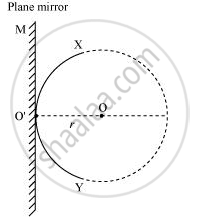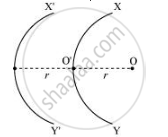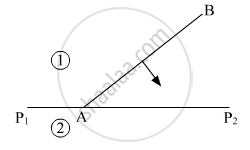Advertisements
Advertisements
प्रश्न
You have learnt in the text how Huygens’ principle leads to the laws of reflection and refraction. Use the same principle to deduce directly that a point object placed in front of a plane mirror produces a virtual image whose distance from the mirror is equal to the object distance from the mirror.
उत्तर
Let an object at O be placed in front of a plane mirror MO’ at a distance r (as shown in the given figure).

A circle is drawn from the centre (O) such that it just touches the plane mirror at point O’. According to Huygens’ Principle, XY is the wavefront of incident light.
If the mirror is absent, then a similar wavefront X’Y’ (as XY) would form behind O’ at distance r (as shown in the given figure).

X'Y' can be considered as a virtual reflected ray for the plane mirror. Hence, a point object placed in front of the plane mirror produces a virtual image whose distance from the mirror is equal to the object distance (r).
APPEARS IN
संबंधित प्रश्न
Using Huygens's construction of secondary wavelets explain how a diffraction pattern is obtained on a screen due to a narrow slit on which a monochromatic beam of light is incident normally.
What is the shape of the wavefront in the following case?
Light diverging from a point source.
The refractive indices of water and diamond are `4/3` and 2.42 respectively. Find the speed of light in water and diamond. (c = 3x108 m/s)
Using Huygens’ principle, verify the laws of reflection at a plane surface.
Derive the law of reflection using Huygen’s Wave Theory.
With what type of source of light are cylindrical wave fronts associated?
Define the term wavefront. Using Huygen’s wave theory, verify the law of reflection.
Define a wavefront. Using 'Huygens' principle, draw the shape of a refracted wavefront, when a plane wave is incident on a convex lens.
Define the term 'wavefront of light'. A plane wavefront AB propagating from a denser medium (1) into a rarer medium (2) is incident of the surface P1P2 separating the two media as shown in fig.
Using Huygen's principle, draw the secondary wavelets and obtain the refracted wavefront in the diagram.

According to Huygens principle, ______.
What is the geometrical shape of the wavefront for:
- Light diverging from a point source?
- The pattern of wavefront of the light from a distant star intercepted by earth?
What is the phase difference between any two points lying on the same?
The inverse square law of intensity is valid for a
Consider a point at the focal point of a convergent lens. Another convergent lens of short focal length is placed on the other side. What is the nature of the wavefronts emerging from the final image?
What is the shape of the wavefront on earth for sunlight?
Two light beams of intensities in the ratio of 9 : 4 are allowed to interfere. The ratio of the intensity of maxima and minima ______.
How is a wavefront different from a ray?
Using Huygen's wave theory of light, show that the angle of incidence is equal to the angle of reflection. Draw a neat and labelled diagram.
Represent diagrammatically how the incident planar wavefronts of wavelength λ pass through an aperture of size d, when d is approximately equal to λ.
